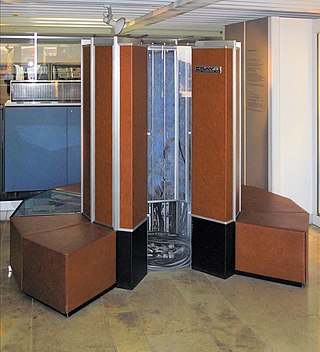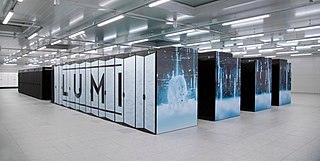
A supercomputer is a type of computer with a high level of performance as compared to a general-purpose computer. The performance of a supercomputer is commonly measured in floating-point operations per second (FLOPS) instead of million instructions per second (MIPS). Since 2017, supercomputers have existed which can perform over 1017 FLOPS (a hundred quadrillion FLOPS, 100 petaFLOPS or 100 PFLOPS). For comparison, a desktop computer has performance in the range of hundreds of gigaFLOPS (1011) to tens of teraFLOPS (1013). Since November 2017, all of the world's fastest 500 supercomputers run on Linux-based operating systems. Additional research is being conducted in the United States, the European Union, Taiwan, Japan, and China to build faster, more powerful and technologically superior exascale supercomputers.
Floating point operations per second is a measure of computer performance in computing, useful in fields of scientific computations that require floating-point calculations.

MareNostrum is the main supercomputer in the Barcelona Supercomputing Center. It is the most powerful supercomputer in Spain, one of thirteen supercomputers in the Spanish Supercomputing Network and one of the seven supercomputers of the European infrastructure PRACE.
The Oak Ridge Leadership Computing Facility (OLCF), formerly the National Leadership Computing Facility, is a designated user facility operated by Oak Ridge National Laboratory and the Department of Energy. It contains several supercomputers, the largest of which is an HPE OLCF-5 named Frontier, which was ranked 1st on the TOP500 list of world's fastest supercomputers as of June 2023. It is located in Oak Ridge, Tennessee.

The TOP500 project ranks and details the 500 most powerful non-distributed computer systems in the world. The project was started in 1993 and publishes an updated list of the supercomputers twice a year. The first of these updates always coincides with the International Supercomputing Conference in June, and the second is presented at the ACM/IEEE Supercomputing Conference in November. The project aims to provide a reliable basis for tracking and detecting trends in high-performance computing and bases rankings on HPL benchmarks, a portable implementation of the high-performance LINPACK benchmark written in Fortran for distributed-memory computers.
The Green500 is a biannual ranking of supercomputers, from the TOP500 list of supercomputers, in terms of energy efficiency. The list measures performance per watt using the TOP500 measure of high performance LINPACK benchmarks at double-precision floating-point format.
The National Center for Computational Sciences (NCCS) is a United States Department of Energy (DOE) Leadership Computing Facility that houses the Oak Ridge Leadership Computing Facility (OLCF), a DOE Office of Science User Facility charged with helping researchers solve challenging scientific problems of global interest with a combination of leading high-performance computing (HPC) resources and international expertise in scientific computing.

Jaguar or OLCF-2 was a petascale supercomputer built by Cray at Oak Ridge National Laboratory (ORNL) in Oak Ridge, Tennessee. The massively parallel Jaguar had a peak performance of just over 1,750 teraFLOPS. It had 224,256 x86-based AMD Opteron processor cores, and operated with a version of Linux called the Cray Linux Environment. Jaguar was a Cray XT5 system, a development from the Cray XT4 supercomputer.
Exascale computing refers to computing systems capable of calculating at least "1018 IEEE 754 Double Precision (64-bit) operations (multiplications and/or additions) per second (exaFLOPS)"; it is a measure of supercomputer performance.

Tsubame is a series of supercomputers that operates at the GSIC Center at the Tokyo Institute of Technology in Japan, designed by Satoshi Matsuoka.

The history of supercomputing goes back to the 1960s when a series of computers at Control Data Corporation (CDC) were designed by Seymour Cray to use innovative designs and parallelism to achieve superior computational peak performance. The CDC 6600, released in 1964, is generally considered the first supercomputer. However, some earlier computers were considered supercomputers for their day such as the 1954 IBM NORC in the 1950s, and in the early 1960s, the UNIVAC LARC (1960), the IBM 7030 Stretch (1962), and the Manchester Atlas (1962), all of which were of comparable power.

Several centers for supercomputing exist across Europe, and distributed access to them is coordinated by European initiatives to facilitate high-performance computing. One such initiative, the HPC Europa project, fits within the Distributed European Infrastructure for Supercomputing Applications (DEISA), which was formed in 2002 as a consortium of eleven supercomputing centers from seven European countries. Operating within the CORDIS framework, HPC Europa aims to provide access to supercomputers across Europe.

Titan or OLCF-3 was a supercomputer built by Cray at Oak Ridge National Laboratory for use in a variety of science projects. Titan was an upgrade of Jaguar, a previous supercomputer at Oak Ridge, that uses graphics processing units (GPUs) in addition to conventional central processing units (CPUs). Titan was the first such hybrid to perform over 10 petaFLOPS. The upgrade began in October 2011, commenced stability testing in October 2012 and it became available to researchers in early 2013. The initial cost of the upgrade was US$60 million, funded primarily by the United States Department of Energy.
XK7 is a supercomputing platform, produced by Cray, launched on October 29, 2012. XK7 is the second platform from Cray to use a combination of central processing units ("CPUs") and graphical processing units ("GPUs") for computing; the hybrid architecture requires a different approach to programming to that of CPU-only supercomputers. Laboratories that host XK7 machines host workshops to train researchers in the new programming languages needed for XK7 machines. The platform is used in Titan, the world's second fastest supercomputer in the November 2013 list as ranked by the TOP500 organization. Other customers include the Swiss National Supercomputing Centre which has a 272 node machine and Blue Waters has a machine that has Cray XE6 and XK7 nodes that performs at approximately 1 petaFLOPS (1015 floating-point operations per second).

Summit or OLCF-4 is a supercomputer developed by IBM for use at Oak Ridge Leadership Computing Facility (OLCF), a facility at the Oak Ridge National Laboratory, capable of 200 petaFLOPS thus making it the 5th fastest supercomputer in the world after Frontier (OLCF-5), Fugaku, LUMI, and Leonardo, with Frontier being the fastest. It held the number 1 position from November 2018 to June 2020. Its current LINPACK benchmark is clocked at 148.6 petaFLOPS.

Epyc is a brand of multi-core x86-64 microprocessors designed and sold by AMD, based on the company's Zen microarchitecture. Introduced in June 2017, they are specifically targeted for the server and embedded system markets.

Fugaku(Japanese: 富岳) is a petascale supercomputer at the Riken Center for Computational Science in Kobe, Japan. It started development in 2014 as the successor to the K computer and made its debut in 2020. It is named after an alternative name for Mount Fuji.

Aurora is a supercomputer that was sponsored by the United States Department of Energy (DOE) and designed by Intel and Cray for the Argonne National Laboratory. It has been the second fastest supercomputer in the world since 2023. It is expected that after optimizing its performance it will exceed 2 ExaFLOPS, making it the fastest computer ever.

LUMI is a petascale supercomputer located at the CSC data center in Kajaani, Finland. As of January 2023, the computer is the fastest supercomputer in Europe.
Hewlett Packard Enterprise El Capitan, is an upcoming exascale supercomputer, hosted at the Lawrence Livermore National Laboratory in Livermore, United States and projected to become operational in 2024. It is based on the Cray EX Shasta architecture. When deployed, El Capitan is projected to displace Frontier as the world's fastest supercomputer.













